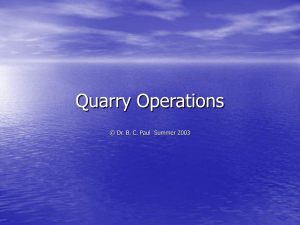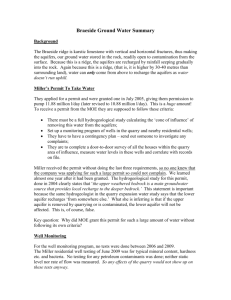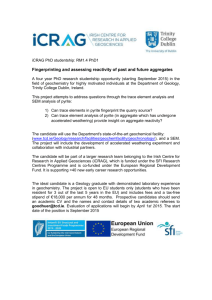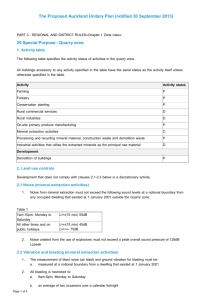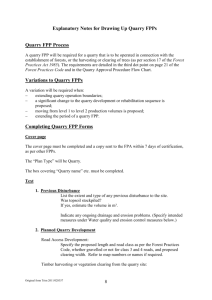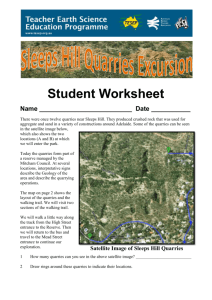"podwiśniówka" quarries in the holy cross mts., poland
advertisement
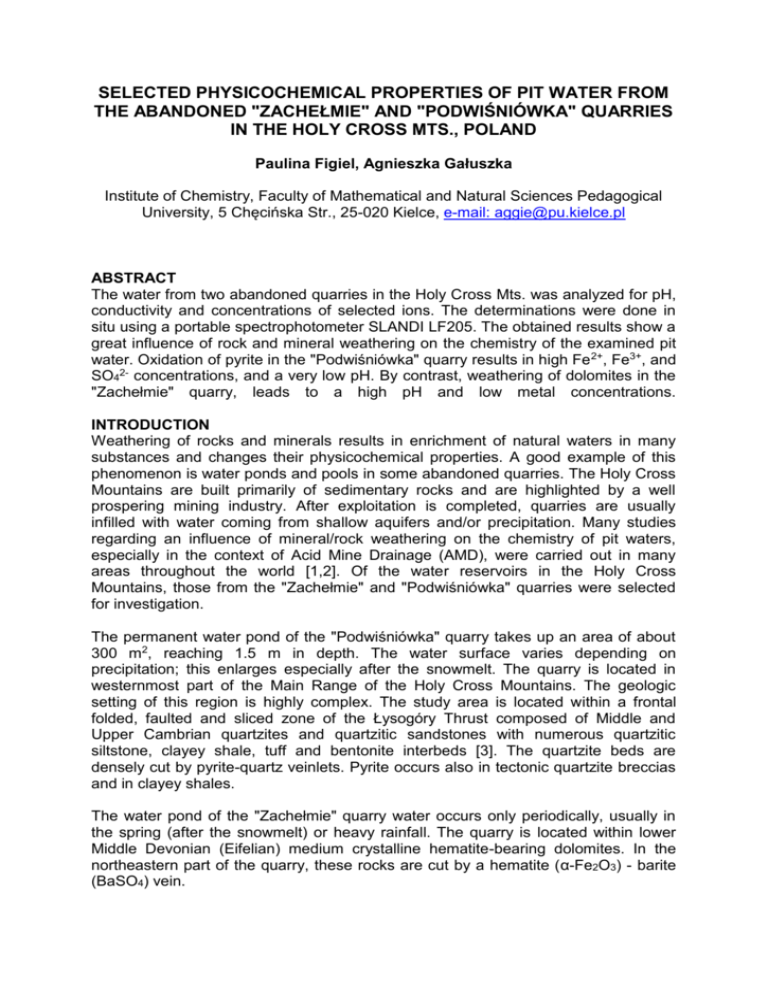
SELECTED PHYSICOCHEMICAL PROPERTIES OF PIT WATER FROM THE ABANDONED "ZACHEŁMIE" AND "PODWIŚNIÓWKA" QUARRIES IN THE HOLY CROSS MTS., POLAND Paulina Figiel, Agnieszka Gałuszka Institute of Chemistry, Faculty of Mathematical and Natural Sciences Pedagogical University, 5 Chęcińska Str., 25-020 Kielce, e-mail: aggie@pu.kielce.pl ABSTRACT The water from two abandoned quarries in the Holy Cross Mts. was analyzed for pH, conductivity and concentrations of selected ions. The determinations were done in situ using a portable spectrophotometer SLANDI LF205. The obtained results show a great influence of rock and mineral weathering on the chemistry of the examined pit water. Oxidation of pyrite in the "Podwiśniówka" quarry results in high Fe 2+, Fe3+, and SO42- concentrations, and a very low pH. By contrast, weathering of dolomites in the "Zachełmie" quarry, leads to a high pH and low metal concentrations. INTRODUCTION Weathering of rocks and minerals results in enrichment of natural waters in many substances and changes their physicochemical properties. A good example of this phenomenon is water ponds and pools in some abandoned quarries. The Holy Cross Mountains are built primarily of sedimentary rocks and are highlighted by a well prospering mining industry. After exploitation is completed, quarries are usually infilled with water coming from shallow aquifers and/or precipitation. Many studies regarding an influence of mineral/rock weathering on the chemistry of pit waters, especially in the context of Acid Mine Drainage (AMD), were carried out in many areas throughout the world [1,2]. Of the water reservoirs in the Holy Cross Mountains, those from the "Zachełmie" and "Podwiśniówka" quarries were selected for investigation. The permanent water pond of the "Podwiśniówka" quarry takes up an area of about 300 m2, reaching 1.5 m in depth. The water surface varies depending on precipitation; this enlarges especially after the snowmelt. The quarry is located in westernmost part of the Main Range of the Holy Cross Mountains. The geologic setting of this region is highly complex. The study area is located within a frontal folded, faulted and sliced zone of the Łysogóry Thrust composed of Middle and Upper Cambrian quartzites and quartzitic sandstones with numerous quartzitic siltstone, clayey shale, tuff and bentonite interbeds [3]. The quartzite beds are densely cut by pyrite-quartz veinlets. Pyrite occurs also in tectonic quartzite breccias and in clayey shales. The water pond of the "Zachełmie" quarry water occurs only periodically, usually in the spring (after the snowmelt) or heavy rainfall. The quarry is located within lower Middle Devonian (Eifelian) medium crystalline hematite-bearing dolomites. In the northeastern part of the quarry, these rocks are cut by a hematite (α-Fe2O3) - barite (BaSO4) vein. EXPERIMENTAL The water samples were collected from the two pit ponds. The sampling design and localization of the investigation areas are shown in figure 1. The results presented in this paper were derived from the investigations performed during two seasons, i.e. in the spring of 2004 and 2005. The principal objective of the first preliminary phase that included only pH and conductivity measurements, was to assess the general chemistry of pit waters from these two quarries. The second phase of investigation gave some more detailed data. All the samples were analyzed in situ. They were collected with PET beakers after having rinsed by analyzed water. Originally, the pH and conductivity were measured with a portable ELMETRON pH- and conductivity-meters. The determinations of alkalinity and selected ions, i.e. sulfate, iron, manganese, zinc, were performed with a portable SLANDI LF205 spectrophotometer. The sets of reagents that were used for analyses are supplied by SLANDI. The conditions of analyses are presented in table 1. Fig. 1. Localization of investigation sites (middle section) and sampling schemes (left and right section) in the "Zachełmie" and "Podwiśniówka" quarries. Table 1. Conditions of analyses with a SLANDI LF205 spectrophotometer.. Parameter Unit 2+ Wavelenght (nm) Detection limits Fe mg dm -3 480 0.1-3.0 Fetotal mg dm-3 585 0.05-6.00 2+ mg dm -3 480 0.05-2.00 mg dm -3 480 5.0-70.0 565 0.02-0.20 Alkalinity mg CaCO3 dm 585 0.0-500.0 Mn SO4 2- Zn2+ mg dm-3 -3 RESULTS AND DISCUSSION The results of water analyses from the "Podwiśniówka" quarry are shown in table 2, whereas those from the "Zachełmie" quarry in table 3. The "Podwiśniówka" pit water has a very low pH and relatively high conductivity. The principal hostrocks, i.e. quartzites, show no acid neutralizing capacity. The pyrite-quartz veins, which pierce the quartzites, weather rapidly and the oxidation products are washed away by rainwater into the pit. This process is the main cause of Acid Mine Drainage (AMD) and has been well described in geochemical literature [1,2,4]. Table 2. The results of water analyses from the "Podwiśniówka" quarry Site Location pH EC μs EC μs, SO42Fetotal Fe2+ pH cm-1 cm-1 mg dm-3 mg dm-3 mg dm-3 April 26th 2004 May 7th 2005 1. W 3.08 638 3.02 504 - - - 2. E 2.85 627 3.07 527 102 8.6 2.6 3. SE 3.20 637 3.08 427 93 9.2 3.0 Note: for sample location see Fig. 1 Two oxidants i.e. oxygen and even more effective ferric (Fe3+) iron participate in oxidation of pyrite [4], which is exemplified by the following reactions: FeS2 (pyrite) + 3,5O2 + H2O → Fe2+ FeS2 + 14Fe3+ + 8H2O → 15Fe2+ + 2SO42- + 16H+ (2) + 2SO42- + 2H+ (1) These two reactions result both in decreasing in pH and raising concentrations of ferrous (Fe2+) and sulfate ions in water [3]. The oxidation of pyrite (reaction 1) is probably initiated by oxygen at pH about 6 because of the low solubility of ferric iron at about neutral pH values. As a result of this reaction, the pH considerably decreases triggering the subsequent reaction (2), which can be 2-3 times orders of magnitude faster than oxygen and gives 8 times more hydrogen ions (but the same amount of sulfate ions). The second reaction occurs primarily in the pit water, and Fe3+ may be derived from both oxidation of Fe 2+ and partial dissolution of hematite/goethite. Both reactions are catalyzed by bacteria Acidithiobacillus ferrooxidans or A. thiooxidans [4]. The pit water from "Podwiśniówka" quarry can be compared with that of surface waters from the other localities of Poland, for example the Sudetes [5], and worldwide [1,2,4]. These waters are characterized by the low pH and very high metal (including iron and aluminum) and sulfate concentrations [4]. The examined water is similar to those only in terms of pH values but not Fe2+, Fe3+ and SO42- concentrations. The uniqueness of the "Podwiśniówka" pit water can be explained by the presence of easily weathering microcrystalline As-pyrite (so-called "gel-pyrite"), the lack of other metal-supplying sulfides (under low pH conditions most of the heavy metals are easily remobilized), as well as the lack of buffering minerals and parent rocks [3]. The differences in pH and conductivity values between the two seasons are associated with natural factors that influence pyrite weathering, e.g. temperature, rainfall, water reservoir depth etc. The seasonal changes in chemistry of the "Podwiśniówka" pit water are described in detail by Migaszewski et al. [3]. The geology setting and hydrochemistry of the "Zachełmie" quarry area is completely different. The pit water is highly alkaline (pH up to 9.89) and has low concentrations of metals (only Zn occurred above detection limits for the analytical technique used). The low conductivity (about 200 μS cm-1) can be ascribed to low solubility of barite and hematite in alkaline environments. The relatively high alkalinity comes from weathering of dolomite that can be described by the following reaction: CaMg(CO3)2 (dolomite) + 2CO2 + 2H2O → Ca2+ + Mg2+ + 4HCO3CO2 is a substrate of this reaction derived from the atmosphere, soil or sediments. As mentioned in the introduction section, hematite and barite mineralization occurs within the quarry boundaries. Barite reveals a very low solubility and does not enrich water in SO42- as shown in table 3. The results from the two investigation seasons are similar. Even though the water pond vanishes periodically, the water chemistry remains relatively stable. Table 3. The results of water analyses from the "Zachełmie" quarry Site Location pH EC μs EC μs Zn2+ SO42Alkalinity pH -1 -1 -3 -3 cm cm mg dm mg dm mgCaCO3 dm-3 April 26th 2004 May 7th 2005 1. N 9.89 127 8.32 200 0.04 5 124 2. NE 9.45 190 8.35 196 - - - 3. NW - - 7.68 185 0.05 9 121 4. W - - 7.84 196 - - - 5. SE - - 9.34 198 - - - Note: for sample location see Fig. 1; Fetotal <0,05 mg dm-3, Mn2+ <0,05 mg dm-3 CONCLUSIONS The analyses of the pit water from the abandoned "Podwiśniówka" and "Zachełmie" quarries allow us to conclude that: 1. The chemistry of the water is strongly influenced by the geological setting (primarily lithology) of the study area. 2. The major factors that govern the chemistry of the analyzed water are natural (weathering of rocks and minerals), but influenced by mining activity. 3. The pH of the examined waters ranges from 2.85 ("Podwiśniówka" quarry) to 9.89 ("Zachełmie" quarry), being unique for natural waters. These values are connected with pyrite (low pH) and dolomite (high pH) weathering. ACKNOWLEDGMENTS The authors would like to thank Prof. Zdzisław M. Migaszewski of the Pedagogical University in Kielce for his support during fieldworks and for reviewing this article, as well as for his valuable remarks that improved the quality of this paper. REFERENCES [1] S. Denimal, C. Bertrand, J. Mudry, Y. Paquette, M. Hochart, M. Steinmann, Applied Geochemistry, 20 (2005): 825-839. [2] N.V. Sidenko, B.L. Sherriff, Applied Geochemistry, 20 (2005):1180-1194. [3] Z.M. Migaszewski, A. Gałuszka, P. Pasławski, Journal of Geochemical Exploration (in print) [4] D.K. Nordstrom, C.N. Alpers, Society of Economic Geologists. Reviews in Economic Geology, 6A (1999): 133-160. [5] P. Jezierski, Doctor‘s Thesis. Institute of Geological Sciences. University of Wrocław. 2002.
